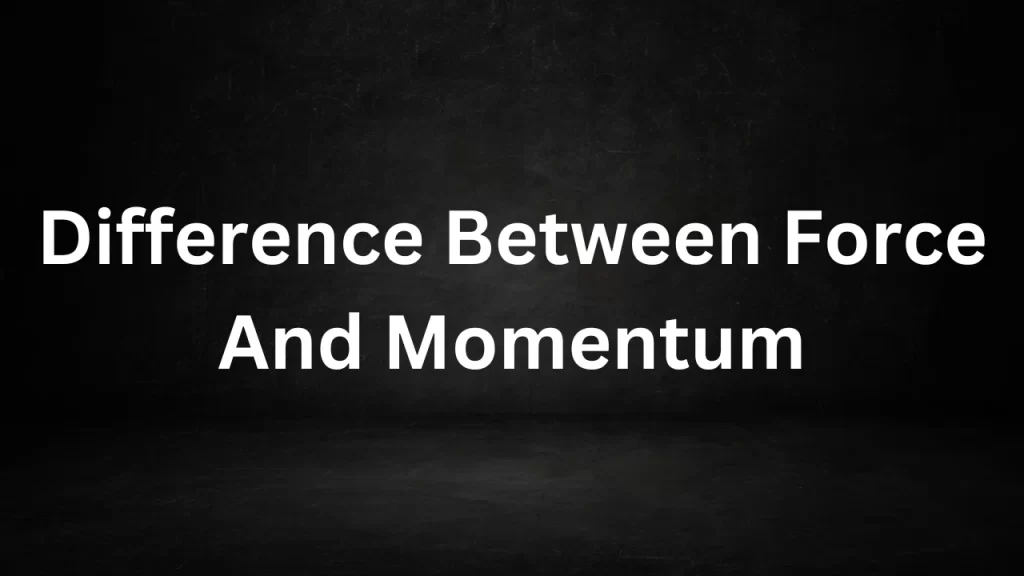Difference Between Force And Momentum: In the realm of physics, the concepts of force and momentum are fundamental to understanding the behavior of objects in motion.
While they both play pivotal roles in the study of dynamics, they are distinct quantities that describe different aspects of an object’s motion. In this article, we will explore the key differences between force and momentum, their definitions, units of measurement, and practical applications.

Difference Between Force And Momentum
Force:
1. Definition:
Force is a vector quantity that represents the interaction between two objects. It is defined as any action that can change the state of motion or shape of an object. Force can either push, pull, or twist an object.
2. Units of Measurement:
The standard unit of force in the International System of Units (SI) is the Newton (N). One Newton is defined as the force required to accelerate a one-kilogram mass by one meter per second squared (1 N = 1 kg·m/s²).
3. Representation:
Force is typically represented by vectors, indicating both its magnitude and direction. Common forces include gravitational force, electromagnetic force, tension, friction, and applied force.
4. Newton’s Laws:
Force is central to Newton’s laws of motion. Newton’s second law states that the acceleration of an object is directly proportional to the net force acting on it and inversely proportional to its mass (F = ma).
Momentum:
1. Definition:
Momentum is also a vector quantity that describes the motion of an object. It is defined as the product of an object’s mass (m) and its velocity (v). Momentum represents the quantity of motion an object possesses.
2. Units of Measurement:
The SI unit of momentum is the kilogram-meter per second (kg·m/s). It can also be expressed in other units like gram-centimeters per second (g·cm/s).
3. Representation:
Momentum is represented by a vector, indicating both its magnitude and direction. The direction of momentum is the same as the direction of an object’s velocity.
4. Conservation of Momentum:
One of the most significant principles related to momentum is the conservation of momentum. In a closed system (where no external forces are acting), the total momentum remains constant before and after any interactions.
Key Differences:
1. Nature:
Force is the interaction between objects, while momentum is a property of an object in motion.
2. Definition:
Force is defined as an action that can change the state of motion or shape of an object, while momentum is the product of mass and velocity, representing the quantity of motion.
3. Units:
Force is measured in Newtons (N), whereas momentum is measured in kilogram-meter per second (kg·m/s).
4. Direction:
Both force and momentum are vector quantities and have direction. However, force is a vector that describes the direction of the push or pull, while momentum’s direction is the same as the direction of the object’s motion.
Practical Applications:
1. Force:
Force is crucial in various applications, including engineering (structural analysis), physics (mechanics and electromagnetism), and everyday life (e.g., lifting objects, driving a car).
2. Momentum:
Momentum is essential in understanding collisions, both in physics experiments and real-world situations, such as car crashes. It also plays a significant role in rocket propulsion, where the expulsion of mass at high velocity generates forward momentum.
Conclusion:
In summary, force and momentum are fundamental concepts in physics, each with its unique characteristics and roles. Force represents the interactions between objects, while momentum quantifies the motion of an object. Understanding the differences between these two quantities is essential for comprehending the dynamics of objects in motion and their behavior in various physical scenarios.
Read More
- Law Of Conservation Of Linear Momentum
- Molecular Weight Of MgSO4
- Molecular Weight Of H3PO4
- Molecular Mass Of CaCl2
- Molecular Mass Of Mg
Frequently Asked Questions (FAQs) On Difference Between Force And Momentum
1. What is the fundamental difference between force and momentum?
Force is an interaction that can change an object’s motion, while (momentum’P’) is a property of an object in motion.
2. How are force and momentum measured differently?
Force is measured in Newtons (N), whereas (momentum’P’) is measured in kilogram-meter per second (kg·m/s).
3. Do force and momentum both have direction?
Yes, both force and momentum are vector quantities, meaning they have magnitude and direction. However, the direction of force represents the push or pull, while the direction of momentum is the same as the direction of an object’s motion.
4. Can force and momentum be negative?
Yes, both force and (momentum’P’) can be negative. Negative force indicates a force in the opposite direction, while negative (momentum’P’) implies motion in the opposite direction.
5. How do force and momentum relate to Newton’s laws of motion?
Force is central to Newton’s second law of motion, which states that the acceleration of an object is directly proportional to the net force acting on it and inversely proportional to its mass. Momentum, on the other hand, is used to describe the state of motion and is conserved in a closed system, as stated in Newton’s third law.
